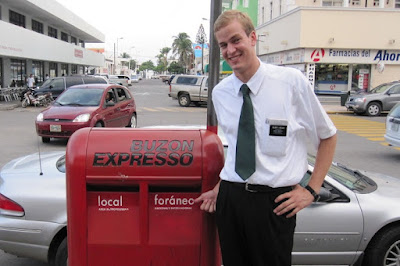November 9, 2007
Our chapel in Xalapa. At
almost every zone conference, the mission takes a group photo and sends copies to
all the missionaries. Due to time constraints, no photo was taken at my first
conference, so I have nothing to post here, sorry.
Our first week of
work was interrupted by my first zone conference. Zone conferences are when the
entire zone of missionaries, corresponding to a region of the mission, get together
for training, instruction, food, and sometimes other amusements as well. The
mission president, his assistants, and others conduct the conference. It’s a
chance for missionaries to get together for a day where they don’t have to face
the usual struggles: the heat, the walking, the rejection, etc. In the Mexico
Veracruz Mission, at the time, we held “multi-zone” conferences, so our zone, covering
the whole city of Xalapa, was joined by the Teziutlán (teh-zyoot-LAN) zone, which
came to Xalapa by bus for the day.
We met in my
area’s chapel. We got there in the morning and said hi to the other missionaries.
This was my first time meeting most of them. I also saw Elder Bowen, who was in
the Xalapa zone with me, as well as two other American missionaries from the
Teziutlán zone that had started at the same time with me. Then Pres.
Johnson and the assistants arrived. Pres. Johnson seemed like he was in a hurry.
This was probably because we had an important guest coming to the conference,
Elder Grow. Elder Grow was a senior church leader and one of three people in
charge of the entire church in Mexico. Among other things, he oversaw all the
mission presidents, so it was no wonder that Pres. Johnson would want things to
be just right. Elder Grow arrived and we started the conference.
The zone
conference started out with a hymn, a prayer, some announcements, and then they
played the arriving and departing missionary videos. Apparently this was a
thing in the mission. Every six weeks, when new missionaries arrived and others
went home, the missionaries in the offices would put together a brief video about
them set to music and interspersed with pictures of the mission and other
church stuff. The arrival video was first. Unbeknownst to me, one of the
assistants must have had a video camera when they picked us up from the airport
earlier that week, because there I was on the screen, giving that funky
handshake-hug to Pres. Johnson with a nervous smile on my face. The departure
video was somewhat more impressive. It consisted of a series of mission photos
submitted by each of the missionaries going home in the next six weeks. Lots of
the photos were of the missionaries in interesting locales and people they had
taught all dressed in white for their baptisms. Included was Elder Guerra’s
segment, as he was going home next month. It was cool; it made me want to have
photos like those at the end of my own mission.
After the
videos, we started the instruction. Elder Grow stood up and started explaining
a few changes that needed to be made in the mission. Before I explain the changes,
let me go through a little bit of what mission expectations were like.
Missionaries are generally under a good deal of pressure to regularly find,
teach, and ultimately baptize new converts to the church. While we recognize
that a person’s choice to join the church is a very personal one, we also
believe that it’s among the most important choices to make. Thus missionaries
are expected to both accommodate the needs of the people they teach, including giving
them spiritual enrichment and respecting their personal decisions, and also to
produce results for the mission.
Since we
consider helping people come to God to be so important, we want to make sure
that our missionaries are working as hard as they can be toward that goal. Each
week, missionary pairs report numbers to their leaders about how many lessons
they taught and how many people they’re teaching that are preparing to join the
church. The process of reporting these numbers allows missionaries to gauge how
hard they’re working and make plans to have more success.
The only
problem with reporting numbers is that sometimes it’s easy to get caught up in
them, rather than think about the real people they represent. That was the main
thrust of what Elder Grow taught us that day. When we arrived to the mission,
the assistants had taught all of us that the Mexico Veracruz Mission had a set
of “Standards of Excellence” which were given as a base set of goals to achieve
each week. I remember being surprised by how high their expectations were. I
also wondered if having such standards actually motivated missionaries to work effectively.
In his presentation,
Elder Grow talked about how much work and planning on the part of the
missionaries goes into preparing an investigator to become a church member. He
said that we often underestimate what it takes, and that’s why we don’t
accomplish it as often as we should. He also reminded us that focusing too much
on reaching certain number thresholds isn’t really what matters; the only
number that really matters is the number of new converts. Everything else is
just to help missionaries work towards that end.


I would have loved to have seen that entrance video. I bet it was a sight to be seen. :)
ReplyDeleteI'm glad you're home.